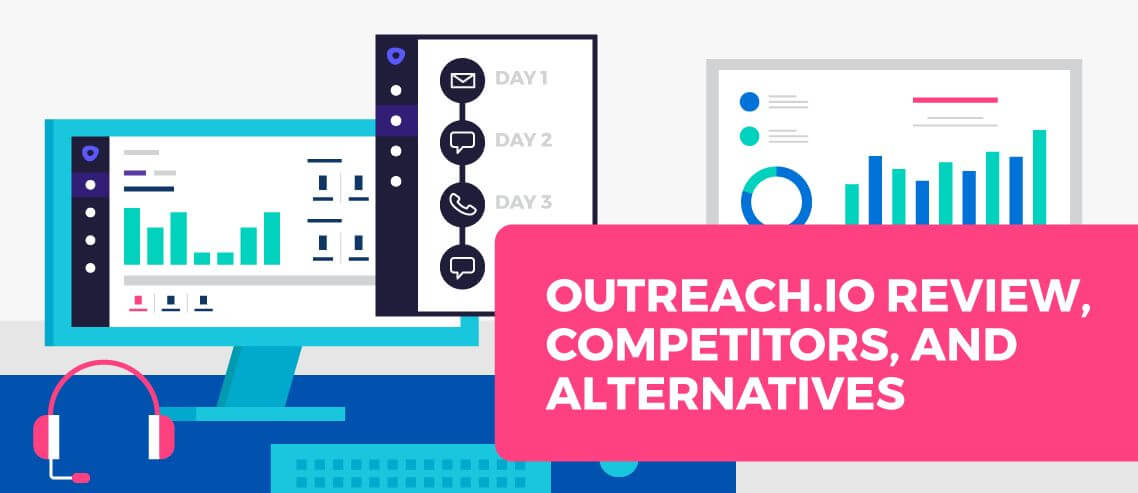Examples of Follow-Up Emails That Get Replies (And Ones That Don’t)

Contents
I know the frustration.
You send out one of the greatest, most brilliant emails you’ve ever written to someone you’re sure is the perfect, ideal client for you…only to get no response.
“What could have gone wrong with this campaign?” you wonder, as you watch your email dashboard stats flatline.
As disheartening as it is, you should know you’re not alone; it happens all the time.
Standing out from the crowd and getting someone’s attention with a cold email is tough, even for the experts. For beginners, it’s nearly impossible.
So what’s the solution?
While there is no miraculous formula for writing a cold email that gets responses (there are some very strong best practices, though), there is one way you can cut through all the noise and usually get replies, fast.
The magic is actually in the follow-up emails.
If you continue to reach out and add value in your follow-up emails, you will be successful.
But before jumping in, let’s see why you should follow up in the first place.
x
Why You Should Continue Sending Value-Packed Follow-up Emails
The most obvious reason? Because most others give up. They send that first email, and then do nothing but pout when they don’t get a response. 70% of unanswered email chains stop after just one message. Only 19% bother to send a second email.
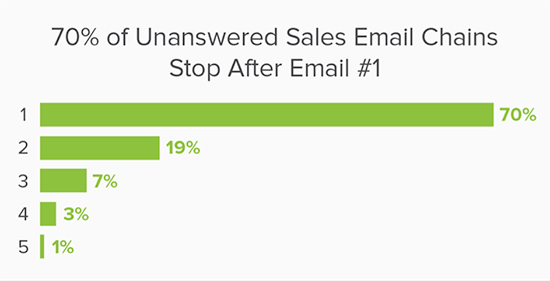
I’m sure you’ve heard this stat: Email is almost 40 times better at acquiring new customers than Facebook and Twitter.
But most people receive hundreds of emails a day – and the chances of your outreach email getting buried or outright deleted are pretty damn high. With so many emails clogging our inbox, we tend to ignore those from people we don’t know. In fact, we delete about 48% of the emails we receive each day.
That’s where follow-up emails can help you get noticed.
According to Yesware, you have a 21% chance of getting a reply to your second email if the first goes unanswered. Every email sent is another opportunity for them to read and reply. Every email sent makes your name that much more recognizable to them.
We tend to believe that follow-up emails annoy people, but the evidence suggests otherwise. They work. Period.
Your follow-up email can also:
- Add value
- Build trust
- Educate
- Entertain
- Inspire someone to take action
Yesware also discovered that it takes an average of five attempts to close a sale, yet 70% of salespeople give up after they don’t get a reply to the first email.
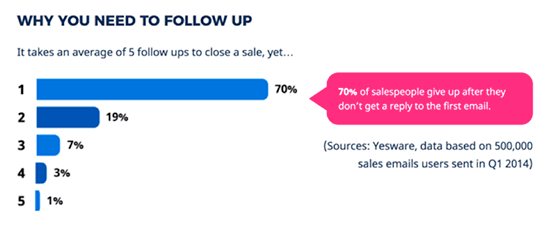
Follow-up, and you’re in the minority, which by itself makes you stand out.
That’s why.
A Follow-up Email That Gets Ignored
The internet is filled with plenty of follow-up email templates. But most aren’t going to deliver the results you expect.
So what are these typical templates? They usually sound something like this:
Hi [Name],
I didn’t hear back from you last week when I was looking for the appropriate person managing the content marketing of [Business Name]. If it makes sense to talk, let me know how your calendar looks. If not, who is the appropriate person?
Thanks
Hey [Name], how’s it going? Can we schedule some time to talk this week?
Cheers
[Name], is the below of any interest to you?
But here’s the thing – these will never work for you. Why?
Because “Follow-up” Doesn’t Mean Bombarding Someone
Let’s say you’re sending a cold sales outreach email. In your first email, you’ve tried to build trust by showing your past work and adding some social proof.
But the prospect didn’t respond.
So you search for a “sales follow-up email template,” and find a template that you think will instantly increase your reply rate.
It may read something like this:
Hey [Name],
I didn’t hear back from you. Just wondering, did I do something wrong?
I know you’re interested in increasing the conversion rate of your sales page.
Let me know.
Talk soon.
But as expected, it also won’t get a reply. Here’s why:
Reason #1: You continued sending weak follow-up emails.
Yes, I know I’m contradicting myself here: the study by Yesware said it takes an average of five attempts to close a sale. But that doesn’t mean you should bombard people with follow-up emails that add no value and simply reiterate what you’ve already said.
It can really tick people off:
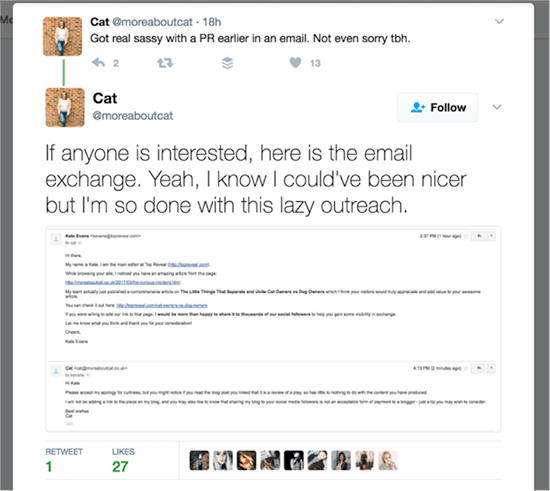
Reason #2: Your follow-up email is all about you.
The world revolves around me. Me, me, me. My favorite person: Me.
I don’t want email from you. I don’t want junk mail from you. I want me-mail.– Seth Godin
If you’re not showing the recipient how your email can benefit them, instead of you, you’re doing it wrong.
Take this example from GetResponse:
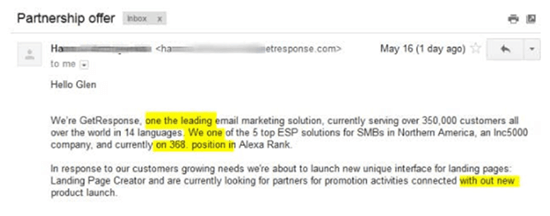
The email is filled with grammatical errors; plus, it’s all about them, not about what they can do for the recipient. Very few would feel inspired to respond to that.
Steli Efti of close.io underscores this point:
The biggest mistake many people make with their follow up emails, is that they make the conversations all about themselves instead of their recipients. Put yourself in your prospect’s shoes. Understand what THEY care about, what’s relevant to THEM. Show them that you understand their specific problems, and that you can help them solve it.
So many cold emails are full of bombastic marketing jargon that’s about YOU: your company, your solution, the awards that you won. Fuck that. Use simple language in your follow ups, don’t try to be clever. Instead, strive to eliminate friction by making it incredibly easy for your prospects to tell you what’s going on with just a quick response, and that’ll show how much you respect their time.
Reason #3: Your follow-up email didn’t close the gap.
You need to close all the gaps as soon as possible with your follow-up emails. But by using a template, you’ve created more gaps, which makes it harder for you to get that all-important response.
Fill in the gaps. Make it about them. Add value with each subsequent email.
A Follow-up Email That Gets Results
I was once reaching out to a potential client for my content marketing services. So, of course, I sent an outreach email:
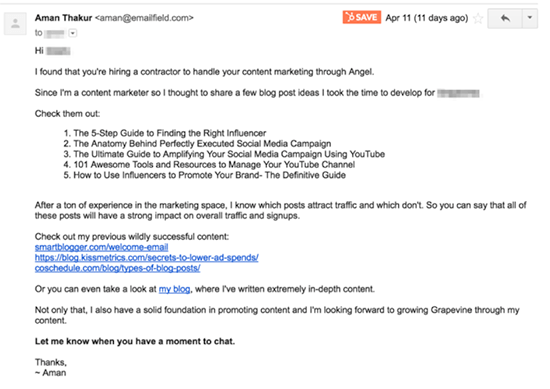
It was a strong email. But unfortunately, the person didn’t respond. Did I give up? I did not.
I went back and sent a follow-up email packed with more value and more social proof.

And…within minutes I got a response.

Do you see what happened there?
Instead of saying “Can we talk next week?”, I sent the outline of a real blog post. I did the actual work and I closed the deal…with the follow-up.
That’s not a one-off. Using this same approach, I’ve written guest posts for sites like CMI, Kissmetrics, and Jeff Bullas.
This is what you need to do. If the person is not interested, then you go one step further to win that deal.
That’s what Sol Orwell does with his emails. And that’s what you should do, too.
How to Craft a Successful Follow-up Email
You can’t send the same type of follow-up email to everyone. Templates are convenient, but not necessarily effective.
Sometimes, you have to provide additional value, show social proof, and add some context. In other situations, you can get what you want just by asking. It just depends on the situation and the individual.
“You could include an attachment or a link to information or an article that would be of interest or add value to them. This will show you have done your research and are willing to go the extra mile to make a difference to them.” ~Jane Jackson
Generally speaking, these are the five elements of a high-converting follow-up email:
1. The Subject Line (quickly explain what the recipient can expect from your email)
2. The Context
- When was the last conversation you had with that person?
- What was it about?
- Is there anything you can reference?
3. Added Value (show you’re willing to do the work; give them something more)
4. Social Proof (adding influence)
5. The Call-to-Action (the exact thing you want the person to do)
Using just these 5 elements you can create the perfect follow-up email.
1. Ensure Your Subject Line is Doing its Job
The aim of your subject line is to get the recipient to open the email. What’s the best way to do that?
- If you have a previous email thread with that person, then reply within that thread. It’s the easiest way to stand out in their inbox.
- If you’ve never connected with that person by email, then you need to write an enticing subject line. Come up with at least one unique hook. Look at how you can help that person.
- Add context (more on that below) to your subject line; for example: “Great to meet you at [Event].”
2. Try Adding a Bit of Context
Beyond the subject line, adding context to your emails makes them fun, engaging, and most importantly, useful to the recipient.
Think about how you could do this:
- Have you had any interaction with that person in the past? Is there anything you can reference, such as a Twitter chat or blog comment?When you add context, you build a personal connection with the recipient. Then it’s much easier to convert them.
- If you haven’t had any conversation or engagement with that person, then you can create context. Take a look at the person’s tweets, for example. All My Tweets is a great tool that can instantly pull all the tweets from a certain account, and list them in a single page. Then it’s just a matter of searching for specific keywords and finding the person’s frustrations or problems – and your follow-up email, of course, should offer a solution to those frustrations or problems.
Jason Zook secured 75% of the 2,000 deals he’s landed over the years through follow-up emails. He did this by adding context and making his emails more personalized.
3. Do Work Upfront to Add Value
What’s the problem you’re solving?
That’s the question you should answer before sending the follow-up email. Instead of asking for links, promoting your product, or pitching your services, think “What value am I offering to this person?”
I created an outline for a prospect and shared it with him. This definitely offered value to that prospect and solved a problem – and helped me close the deal.
Take some time to figure out the problem your prospect has and aim to solve it with your follow-up email.
4. Use Social Proof to Make it More Appealing
Social proof is an extremely powerful tool. Over 70% of Americans say they look at product reviews before making a purchase, and 84% of them trust reviews as much as a personal recommendation.
“By using social proof in the form of testimonials, reviews and trust icons you’re helping customers make a decision, feel confident about their choice, and a part of something bigger.” ~Talia Wolf
That means social proof is the #1 factor people take into consideration to assist their decision. It’s a no-brainer to include it in your outreach emails.
Tim Soulo loves using social proof to quickly gain credibility. He used it with this outreach email:
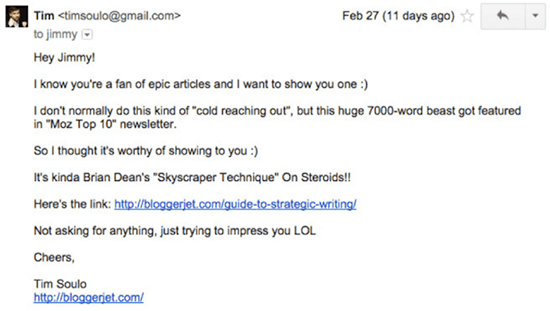
What are some other kinds of social proof you can use in your follow-up emails?
- Case studies of brands you’ve worked with
- Results you’ve achieved
- Previews of the content you’ve published online
- Customer reviews, ratings, and testimonials
5. Add a call-to-action
Finally, your follow-up email should always include a specific call-to-action.
You don’t need to play with words here. A quick ask will be enough: “Let’s talk about it – a short Skype will do. Are you available this Friday?”
Most of the time, you’d like to get your prospect to take any one of these actions:
- Connect with you on the phone
- Add a link
- Share your content
- Chat with you
- Sign up, subscribe, or download
Another useful trick is to ask a question. Emails with 1-3 questions in them were 50% more likely to get a response than those without any. We see a question, we typically want to answer it.
So, what do you want them to do??
Add it to your email. You won’t get if you don’t ask.
Follow-up Email Templates
So, you now know what constitutes a great follow-up email – but how do you create one? Here are some templates that may be helpful to get you started.
Remember, there are two types of follow-ups:
- A follow-up email to a person you already know, have met, or have some sort of connection with
- A follow-up email to a person you have never had any communication with in the past
Of course, it’s easier to follow up with the person you already know.
A simple follow-up email with a little bit of context would be enough:
[ms_email_template id=4744 /]
But you can’t use this email for a person you don’t know, as you obviously won’t know what their unique problems are.
That’s where these follow-up templates come in. They can help you get a response from virtually anyone. While I would never recommend using an email template verbatim, I don’t see a single reason why you can’t use them as a building block.
Once you know which template you want to use, edit and personalize it to make sure it fits with your situation and reflects your personality.
Template for Link Building
How do you approach link building?
Most times, you send an email which contains a link to an outdated article or a broken link, and then tell the site owner you’ve published a fresh, updated article, which could be a great addition to their content. Sound familiar? It’s a tried-and-true method.
But most of the time, that’s not enough to guarantee a response.
If your email is met with deafening silence, here’s a follow-up email template that might help:
[ms_email_template id=4745 /]
Template for Sales Outreach
Let’s say you’re a freelance designer and pitched a client for your design services.
In your outreach email, you listed all the companies you’ve helped in the past, plus you’ve also shared an idea about how you can help them with their branding.
While there are other ways to get on their radar, digital magic can happen with this follow-up email.
[ms_email_template id=4746 /]
Template for Guest Post
How do you secure a guest post on a bigger publication?
Normally, you do this by writing a great outreach email which contains every important element: introduction, headline ideas for the guest post, and links to your previously published content.
But sometimes, even all that isn’t enough. In those cases, you can use this follow-up email that’ll instantly show you as the brilliant, hard working writer you are.
[ms_email_template id=4748 /]
How to Master Sending Follow-up Emails
So you’ve written an inspired follow-up email, but when should you send it?
Here is my suggested timing for sending follow-up emails:
- For sales outreach: after 24 hours
- For link building and guest posts: after 48 hours
- To catch up with a connection: once a month
In short, there’s no hard-and-fast rule for sending a follow-up email. It’s usually always safe to send a follow-up email after 48 hours, as the person has had enough time to consider your original email.
However, if you’re reaching out to the busy CEO of a big enterprise, give them more time – maybe 4-7 days – before you send your first follow-up.
You also need to think about how many times to follow up with a prospect.
If you’re reaching out to a completely cold lead, I wouldn’t recommend sending more than two follow-ups. However, if you’ve already had some kind of interaction with that person, you can send as many follow-ups as it takes to get a response. Some research suggests you keep going – adding value and social proof as you go – until you get that response.
Automate Your Follow-Up Sequence
If you’re reaching out to hundreds of prospects every week, it’s impossible to manually stay on top of following up with all of them.
That’s why a sales engagement tool like Mailshake is essential to creating an effective, scalable follow-up email sequence.
With Mailshake, you can personalize your emails in bulk with powerful mail merge features, schedule follow-up emails that are paused or triggered based on whether a a recipient opens an email, clicks a link, or replies, and reply to leads straight from your Mailshake dashboard with Lead Catcher.
You can also set the amount of time between follow-ups (5 days between the first and second email, 7 days between the second and third, etc.), and the days and times you want them to send (for instance, between 8 am and 6 pm on weekdays).
[lyte id=”XkdjhruF77s” /]
Optimize your copy and overall outreach strategy by AB testing different subject lines, body copy, and full campaign sequences. And with native integrations to your CRM, and third party integrations to hundreds of software tools via Zapier, you can automate your outreach even further by triggering campaigns when someone downloads an eBook, books a meeting, or signs up for a demo.
If social media and phone are a part of your outreach cadence, you can include those touchpoints in your outreach cadences as well with Mailshake Sales Engagement.
Bottom line: following up is absolutely essential to an effective outreach strategy, but there’s no reason why you can’t automate it.
Stop Waiting and Start Doing
Having a steady stream of clients and promoters for your brand sounds great, but it doesn’t happen automatically or overnight; we need to hustle, find, and pursue our prospects.
Not getting a response from your outreach email is not a legitimate reason to procrastinate. If anything, that’s the moment to buckle down and get to work.
Now you know that follow-up emails can help you get those crucial replies. And I’ve just handed you a proven strategy for building your business with email campaigns that always include follow-up emails.
No more excuses. Start today and reach out to all the people you’ve tried contacting in the past, but didn’t reply the first time around.
You have nothing to lose – and everything to gain.




